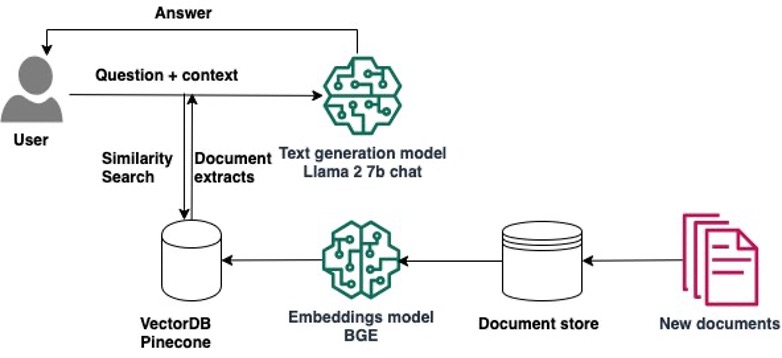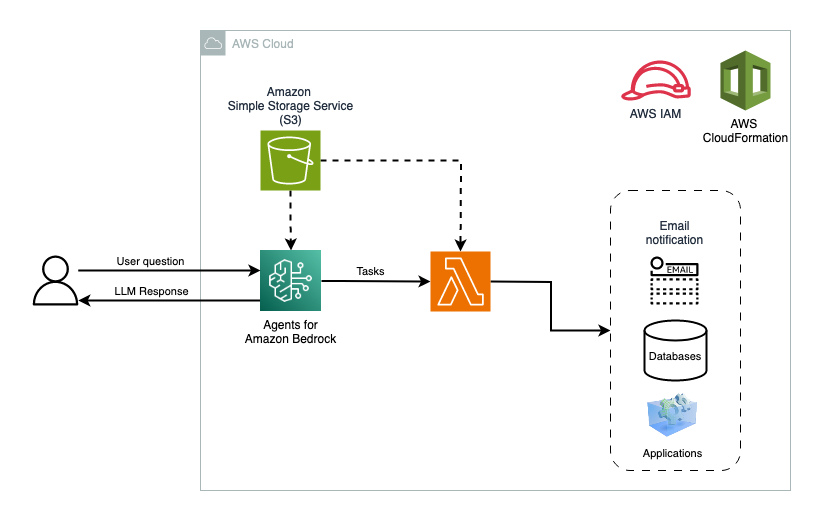AWS Machine Learning Blog
Category: Artificial Intelligence
Amazon Textract’s new Layout feature introduces efficiencies in general purpose and generative AI document processing tasks
Amazon Textract is a machine learning (ML) service that automatically extracts text, handwriting, and data from any document or image. AnalyzeDocument Layout is a new feature that allows customers to automatically extract layout elements such as paragraphs, titles, subtitles, headers, footers, and more from documents. Layout extends Amazon Textract’s word and line detection by automatically […]
Use Amazon SageMaker Studio to build a RAG question answering solution with Llama 2, LangChain, and Pinecone for fast experimentation
Retrieval Augmented Generation (RAG) allows you to provide a large language model (LLM) with access to data from external knowledge sources such as repositories, databases, and APIs without the need to fine-tune it. When using generative AI for question answering, RAG enables LLMs to answer questions with the most relevant, up-to-date information and optionally cite […]
KT’s journey to reduce training time for a vision transformers model using Amazon SageMaker
KT Corporation is one of the largest telecommunications providers in South Korea, offering a wide range of services including fixed-line telephone, mobile communication, and internet, and AI services. KT’s AI Food Tag is an AI-based dietary management solution that identifies the type and nutritional content of food in photos using a computer vision model. This […]
Moderate your Amazon IVS live stream using Amazon Rekognition
Amazon Interactive Video Service (Amazon IVS) is a managed live streaming solution that is designed to provide a quick and straightforward setup to let you build interactive video experiences and handles interactive video content from ingestion to delivery. With the increased usage of live streaming, the need for effective content moderation becomes even more crucial. […]
Retrieval-Augmented Generation with LangChain, Amazon SageMaker JumpStart, and MongoDB Atlas Semantic Search
Generative AI models have the potential to revolutionize enterprise operations, but businesses must carefully consider how to harness their power while overcoming challenges such as safeguarding data and ensuring the quality of AI-generated content. The Retrieval-Augmented Generation (RAG) framework augments prompts with external data from multiple sources, such as document repositories, databases, or APIs, to […]
Build a foundation model (FM) powered customer service bot with agents for Amazon Bedrock
From enhancing the conversational experience to agent assistance, there are plenty of ways that generative artificial intelligence (AI) and foundation models (FMs) can help deliver faster, better support. With the increasing availability and diversity of FMs, it’s difficult to experiment and keep up-to-date with the latest model versions. Amazon Bedrock is a fully managed service […]
Philips accelerates development of AI-enabled healthcare solutions with an MLOps platform built on Amazon SageMaker
This is a joint blog with AWS and Philips. Philips is a health technology company focused on improving people’s lives through meaningful innovation. Since 2014, the company has been offering customers its Philips HealthSuite Platform, which orchestrates dozens of AWS services that healthcare and life sciences companies use to improve patient care. It partners with […]
Fine-tune Whisper models on Amazon SageMaker with LoRA
Whisper is an Automatic Speech Recognition (ASR) model that has been trained using 680,000 hours of supervised data from the web, encompassing a range of languages and tasks. One of its limitations is the low-performance on low-resource languages such as Marathi language and Dravidian languages, which can be remediated with fine-tuning. However, fine-tuning a Whisper […]
Use foundation models to improve model accuracy with Amazon SageMaker
Determining the value of housing is a classic example of using machine learning (ML). In this post, we discuss the use of an open-source model specifically designed for the task of visual question answering (VQA). With VQA, you can ask a question of a photo using natural language and receive an answer to your question—also in plain language. Our goal in this post is to inspire and demonstrate what is possible using this technology.
Implement a custom AutoML job using pre-selected algorithms in Amazon SageMaker Automatic Model Tuning
AutoML allows you to derive rapid, general insights from your data right at the beginning of a machine learning (ML) project lifecycle. Understanding up front which preprocessing techniques and algorithm types provide best results reduces the time to develop, train, and deploy the right model. It plays a crucial role in every model’s development process […]









